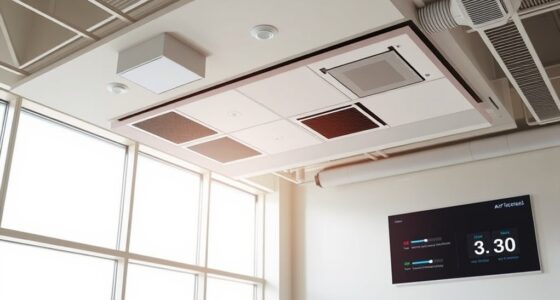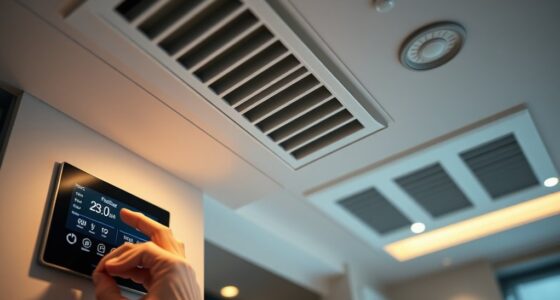To optimize airflow patterns for occupant comfort and IAQ, focus on visualizing and adjusting airflow using tools like smoke tests or CFD simulations. Place vents and diffusers carefully, adjusting angles to prevent drafts and dead zones, ensuring even air distribution. Monitor air quality continuously and fine-tune your system based on data to reduce stagnation and turbulence. By implementing these strategies, you’ll create a healthier, more comfortable space—keep exploring to learn more ways to enhance airflow effectively.
Key Takeaways
- Utilize airflow visualization tools like smoke tests and CFD simulations to identify stagnation and turbulence areas.
- Adjust vent and diffuser placement and angles to promote even air distribution and reduce drafts.
- Minimize dead zones and high-velocity zones to improve indoor air quality and occupant comfort.
- Implement sensor-based, dynamic ventilation controls for real-time airflow optimization.
- Regularly monitor airflow patterns and modify system settings to maintain balanced and effective ventilation.

Enhancing airflow patterns is crucial for improving efficiency and air quality in any space. When you focus on airflow visualization, you gain a clearer understanding of how air moves within a room or building. This insight allows you to identify areas where airflow is weak, stagnant, or excessively turbulent. By analyzing airflow visualization data, you can develop targeted ventilation strategies that promote even distribution of fresh air and remove pollutants effectively. Proper ventilation strategies are the backbone of a healthy indoor environment, ensuring that occupants breathe cleaner air and that energy isn’t wasted on inefficient airflow.
Optimizing airflow improves indoor air quality and energy efficiency through targeted visualization and ventilation strategies.
To start, you need to map out the existing airflow patterns carefully. Using airflow visualization tools, such as smoke tests, computational fluid dynamics (CFD) simulations, or infrared thermography, helps you see exactly how air behaves around obstacles, furniture, and structural features. This visual approach reveals dead zones where stale air might linger or areas where air velocities are too high, creating discomfort or noise issues. With this knowledge, you can make informed adjustments to duct placement, vent locations, and diffuser angles, enhancing the overall airflow. These modifications help balance the airflow, preventing drafts or uneven temperature distribution that could compromise occupant comfort.
Implementing effective ventilation strategies involves creating a systematic plan that takes into account the room’s purpose, occupancy levels, and air quality standards. For example, in a workspace, you might prioritize localized exhausts or increased fresh air intake near high-occupancy zones. For residential spaces, balancing supply and return vents ensures consistent temperature and air quality without over-conditioning the environment. Properly designed airflow patterns reduce energy consumption by minimizing the need for constant heating or cooling, which is often caused by poorly distributed airflow. It’s also essential to consider the placement of sensors and control systems to adapt ventilation dynamically based on real-time occupancy and air quality data.
Continuous monitoring and adjustment are critical to maintaining ideal airflow. Use sensors to track parameters like CO2 levels, humidity, and particulate matter, then fine-tune ventilation strategies accordingly. Regular airflow visualization assessments help verify that changes made are effective and that airflow remains balanced over time. Remember, the goal isn’t just to move air but to move it intelligently—distributing fresh air where it’s needed most while exhausting stale or contaminated air efficiently. When you enhance airflow patterns through thoughtful visualization and ventilation strategies, you elevate occupant comfort, improve indoor air quality, and reduce energy costs, creating healthier, more comfortable environments for everyone.
Additionally, incorporating high-quality airflow visualization techniques can provide more accurate insights, ensuring that your ventilation improvements are based on precise data and real-world conditions.
Frequently Asked Questions
How Does Airflow Pattern Influence Energy Efficiency?
Airflow patterns directly impact energy efficiency by reducing turbulence and ensuring smooth air movement. Proper ventilation zoning directs airflow to where it’s needed most, minimizing wasted energy. When you control turbulence, fans and HVAC systems work less hard, lowering energy consumption. Efficient zoning prevents over-conditioning spaces, so you save on heating and cooling costs. Overall, optimizing airflow patterns makes your building more energy-efficient by balancing comfort and system performance.
What Role Does Occupant Movement Play in Airflow Optimization?
Occupant movement acts like a conductor, orchestrating airflow variability throughout a space. When you move, it influences how air circulates, creating shifts that can either improve or disrupt airflow patterns. By understanding and accommodating these movements, you can optimize airflow, ensuring consistent comfort and better indoor air quality. Your activity helps maintain a dynamic balance, preventing stagnant zones and promoting a healthier, more comfortable environment.
Can Airflow Adjustments Reduce HVAC System Wear and Tear?
Yes, airflow adjustments can reduce HVAC system wear and tear. By optimizing duct design and ensuring proper air filter maintenance, you improve airflow efficiency, minimizing strain on the system. Properly designed ducts prevent unnecessary pressure and airflow disruptions, while clean filters keep the system running smoothly. These measures help your HVAC operate more effectively, extend its lifespan, and reduce the likelihood of breakdowns, saving you money on repairs and energy costs.
How Do Airflow Patterns Impact Allergen Distribution?
Airflow patterns directly influence how airborne allergens distribute throughout your space. Properly designed airflow creates favorable distribution dynamics, preventing allergens from settling in one area and reducing their concentration in the air you breathe. By adjusting vents and airflow directions, you can minimize allergen accumulation in occupied zones, improving indoor air quality and comfort. This targeted approach helps keep airborne allergens in check, making your environment healthier and more comfortable.
Are There Specific Tools to Measure Airflow Effectiveness?
Yes, you can use tools like anemometers and airflow visualization devices to measure airflow effectiveness. Anemometers, when properly calibrated, provide precise velocity readings, ensuring accurate assessments. Airflow visualization techniques, such as smoke or dye tests, help you see flow patterns clearly. These tools enable you to identify areas for improvement, optimize airflow, and enhance both occupant comfort and indoor air quality effectively.
Conclusion
By fine-tuning airflow patterns, you’ll guarantee your space feels as cozy as a Victorian parlor, with fresh air circulating smoothly and occupants breathing easy. Think of yourself as the master conductor, guiding each gust to dance harmoniously across the room. Remember, just like the legendary Leonardo da Vinci sketched his inventions centuries ago, your careful adjustments today can create a timeless comfort that keeps everyone happy and healthy. So, take charge and let ideal airflow be your masterpiece.










